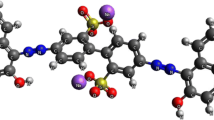Abstract
The bark of Moringa oleifera, a cheap and readily available natural biopolymeric resource material, found to significantly reduce coliform load and turbidity in contaminated water is investigated in this paper. Its surface and adsorptive properties are investigated to explore its adsorptive potential in removing V(V) from aqueous solutions. Surface properties were investigated using FTIR, HRSEM/EDS, IC, and BET-N2 adsorption techniques. Adsorptive properties were investigated by optimizing adsorption parameters such as pH, temperature, initial metal concentration, and adsorbent dosage, using V(V) as an adsorbate. The adsorption-desorption isotherms are typical of type II with a H3 hysteresis loop and is characteristic of a largely macroporous material. Bottle ink pores are observed, which can provide good accessibility of the active sites, even though the internal BET surface area is typically low (1.79 g/m2). Solution pH significantly influences the adsorptive potential of the material. The low surface area negatively impacts on the adsorption capacity, but is compensated for by the exchangeable anions (Cl−, F−, PO4 3−, NO3 −, and SO4 2−) and cations (Ca2+, K+, Mg2+, and Al3+) at the surface and the accessibility of the active sites. Adsorption isotherm modeling show that the surface is largely heterogeneous with complex multiple sites and adsorption is not limited to monolayer.












Similar content being viewed by others
References
Abbaslou, R., Vosoughi, V., & Dalai, A. K. (2017). Comparison of nitrogen adsorption and electron microscopy analyses for structural characterization of carbon nanotubes. Applied Surface Science, 419, 817–825.
Alo, M., Anyim, C., & Elom, M. (2012). Coagulation and antimicrobial activities of Moringa oleifera seed storage at 3oC temperature in turbid water. Advances in Applied Science Research, 3(2), 887–894.
Bozbaş, S. K., & Boz, Y. (2016). Low-cost biosorbent: Anadara inaequivalvis shells for removal of Pb(II) and Cu(II) from aqueous solution. Process Safety and Environmental Protection, 103, 144–152.
Bradfield, E. D., & Cooke, D. T. (1985). Determination of inorganic anions in water extracts of plants and soils by ion chromatography. Analyst, 110, 1409–1410.
Deng, S., Wei, H., Chen, T., Wang, B., Huang, J., & Yu, G. (2014). Superior CO2 adsorption on pine nut-shell derived activated carbons and the effective micropores at different temperatures. Chemical Engineering Journal, 253, 46–54.
Fujimoto, Y., & Saito, S. (2016). Gas adsorption, energetics and electronic properties of boron and nitrogen doped bilayer graphenes. Chemical Physics, 478, 55–61.
Gargari, J. E., Kalal, H. S., Shakeri, A., & Khanchi, A. (2017). Synthesis and characterization of silica/polyvinyl imidazole/H2PO4-coreshell nanoparticles as recyclable adsorbent for efficient scavenging of Sm (III) and Dy(III) from water. Journal of Colloid and Interface Science, 505, 745–755.
Gregg, S. J., & Sing, K. S. (1982). Adsorption surface area and porosity (second ed.p. 303). London: Academic press.
Klapiszewski, L., Katarzyna Siwinska-Stefanska, K., & Kołodynska, D. (2017). Preparation and characterization of novel TiO2/lignin and TiO2-SiO2/lignin hybrids and their use as functional biosorbents for Pb(II). Chemical Engineering Journal, 314, 169–181.
Lapham, D., & Lapham, J. (2017). Gas adsorption on commercial magnesium stearate: effects of degassing conditions on nitrogen BET surface area and isotherm characteristics. International Journal of Pharmaceutics, 530, 364–376.
Mnisi, R. L., Ndibewu, P. P., & Mokgalaka, N. S. (2012). Functionalization of a natural biopolymer with aliphatic polyamines and its sorption properties for vanadium removal from aqueous solutions. South African Journal of Chemistry, 65, 62–65.
Ndibewu, P. P., Mnisi, R. L., Mokgalaka, N. S., & McCrindle, R. I. (2011). Heavy metal removal in aqueous systems using Moringa oleifera: a review. Journal of Material Sciences & Engineering, B1, 843–853.
Nishi, Y., & Inagaki, M. (2016). Gas adsorption/desorption isotherm for pore structure characterization. Materials Science and Engineering of Carbon, 227–247.
Odler, I. (2003). The BET-specific surface area of hydrated Portland cement and related materials. Cement and Concrete Research, 33, 2049–2056.
Okuda, T., Baes, A., Nishijimam, W., & Okadam, M. (2000). Isolation and characterization of coagulant extracted from Moringa oleifera seed by salt solution. Water Resources, 35, 405–410.
Prasad, R. K. (2009). Color removal from distillery spent wash through coagulation using Moringa oleifera seeds: Use of optimum response surface methodology. Journal of Hazardous Materials, 165, 804–811.
Reddy, D. H. K., Seshaiah, K., Reddy, A. V. R., Rao, M. M., & Wang, M. C. (2010). Biosorption of Pb2+ from aqueous solutions by Moringa oleifera bark: equilibrium and kinetic studies. Journal of Hazardous Materials, 174(1), 831–838.
Vazhappilly, T., Ghanty, T., & Jagatap, B. (2017). Adsorption properties of fission gases Xe and Kr on pristine and doped graphene: a first principle DFT study. Journal of Nuclear Materials, 174–180.
Vieira, A. M., Vieira, M. F., Silva, G. F., Araújo, Á. A., Fagundes-Klen, M. R., Veit, M. T., & Bergamasco, R. (2010). Use of Moringa oleifera seed as a natural adsorbent for wastewater treatment. Water, Air, and Soil Pollution, 206(1–4), 273–281.
Wlodarczyk-Stasiak, M., & Jamroz, J. (2009). Specific surface area and porosity of starch extrudates determined from nitrogen adsorption data. Journal of Food Engineering, 93, 379–385.
Zeng, X., Yao, H., Ma, N., Fan, Y., Wang, C., & Shi, R. (2011). Synthesis, characterization and adsorption performance of a novel post-crosslinked adsorbent. Journal of Colloid and Interface Science, 354, 353–358.
Acknowledgements
The authors are grateful to the Tshwane University of Technology for financial support.
Author information
Authors and Affiliations
Corresponding author
Rights and permissions
About this article
Cite this article
Mnisi, R.L., Ndibewu, P.P. Surface and adsorptive properties of Moringa oleifera bark for removal of V(V) from aqueous solutions. Environ Monit Assess 189, 606 (2017). https://doi.org/10.1007/s10661-017-6329-0
Received:
Accepted:
Published:
DOI: https://doi.org/10.1007/s10661-017-6329-0




